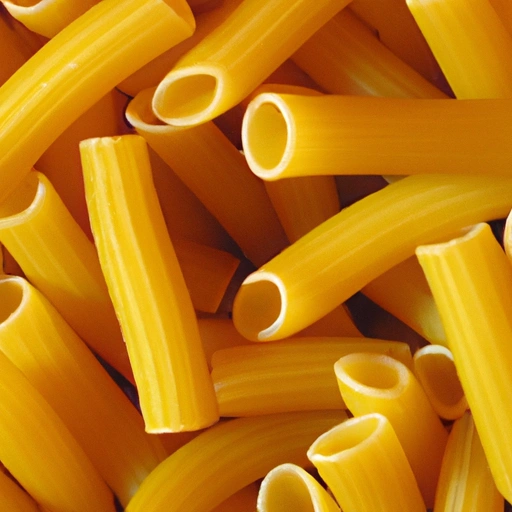Mostaccioli
Description

Mostaccioli is a popular type of pasta that originated in Italy and has become a favorite worldwide. It is a smooth, tube-shaped pasta that is similar to penne but without the ridges. The name mostaccioli is derived from the Italian word 'mustaccioli', which is a traditional Italian cookie. This association is likely due to the pasta's resemblance in shape to the cookie. Mostaccioli is typically cut at an angle, making it perfect for holding onto sauces and ingredients in a variety of dishes.
Common uses
In culinary traditions, mostaccioli is often used in baked pasta dishes, such as mostaccioli al forno, where it is mixed with a hearty meat sauce and cheese before being baked to perfection. It is also popular in pasta salads, served cold with a variety of vegetables, cheese, and a light dressing. Additionally, mostaccioli is a great choice for hearty soups and stews, as it holds its shape well during the cooking process.
Nutritional value
Calories
A 2-ounce (56g/1/2 cup) serving of dry mostaccioli typically contains approximately 200 calories.
Protein
Mostaccioli provides about 7 grams of protein per serving, making it a good source for maintaining muscle health.
Fat
This pasta is low in fat, with less than 1 gram per serving.
Carbohydrates
Mostaccioli is primarily composed of carbohydrates, with about 42 grams per serving.
Vitamins
Mostaccioli is often enriched with B-vitamins such as folic acid, which is important for cell health.
Minerals
It typically contains iron, which is essential for blood health, and other minerals depending on the brand and enrichment.
Health benefits
Mostaccioli, like other whole grain pastas, can be a part of a healthy diet. Whole grain versions provide more fiber, which can aid in digestion and provide a feeling of fullness, possibly aiding in weight management. The protein content in mostaccioli can contribute to muscle maintenance and repair, while the low-fat nature makes it a heart-healthy option when consumed in moderation.
Potential risks
As with any pasta, mostaccioli is high in carbohydrates, which can lead to weight gain if consumed in large quantities. Additionally, those with gluten sensitivity or celiac disease should avoid traditional mostaccioli made from wheat. However, gluten-free options are available.
Common recipes
Mostaccioli is commonly used in recipes such as mostaccioli al forno, pasta salads, casseroles, and in combination with a variety of sauces ranging from classic tomato to creamy Alfredo.
Cooking methods
It is typically boiled in salted water for about 8-10 minutes until al dente. For baked dishes, it is often parboiled before being mixed with other ingredients and finished in the oven.
Pairing with other ingredients
Mostaccioli pairs well with robust and hearty meat sauces, cream-based sauces, and can also be enjoyed with simple garlic and olive oil. It complements a wide array of ingredients including vegetables, cheese, and herbs.
Summary
Mostaccioli is a versatile, tube-shaped pasta that is beloved in Italian cuisine and enjoyed around the world. With its robust shape and ability to pair with countless ingredients, it is a favorite for many pasta dishes. Mostaccioli's nutritional profile makes it a wholesome choice when consumed in moderation, and it can be found in both traditional and gluten-free forms to accommodate different dietary needs. Whether baked, boiled, or tossed in a salad, mostaccioli is a delightful ingredient that brings Italian flair to any meal.